8.10 Fall Prevention
Client falls are the most reported client safety events in British Columbia and account for 40% of all adverse events (BCPSLS Central, 2015). Falls are a major priority in health care, and health care providers are responsible for identifying, managing, and eliminating potential hazards to clients. Older adults may be at increased risk for falls due to impaired mental status, decreased strength, impaired balance and mobility, and decreased sensory perception (Titler et al., 2011). Other clients may be at risk due to gait problems, cognitive ability, visual problems, urinary frequency, generalized weakness, and cognitive dysfunction. Specific treatments and medications may cause hypotension or drowsiness, which increases a client’s risk for falls (Hook & Winchel, 2006).
If the client begins to fall during a transfer, never try to keep them from falling as this may cause both you and the client injury. Instead, you will assist the client to fall. First, widen your stance and bring the client’s body close to you to provide support. Bend your knees and using the strength of your thighs, lower the client to the ground. Health Care Assistants should report the near fall or any actual falls immediately to their supervisor. Do not attempt to get the client up alone. The agency may require the client gets evaluated by a nurse before helping the client back up. Report any injuries or concerns. Health Care Assistants will also likely be required to complete documentation following the agency policies.
Fall Prevention Strategies
All clients should be observed and evaluated for risk factors, and necessary prevention measures should be implemented as per agency policy. Table 8.7 lists factors that affect client safety and general measures to prevent falls in health care.
Prior to ambulation consider the following risk factors:
- Age of client
- Sensory-perception alteration
- Cognitive impairment (decreased LOC, confusion)
- Poly-pharmacology
- Urinary incontinence
- Ability to communicate (language barriers)
- Lack of safety awareness (height of bed, attachments and tubes)
- Environmental factors (dim light, tripping hazards, uneven floors)
| Prevention Strategies | Safety Measures |
|---|---|
| Look for fall risk factors in all clients. | Identifying specific factors helps you implement specific preventive measures. Risk factors include age, weakness on one side, the use of a cane or walker, history of dizziness or lightheadedness, low blood pressure, and weakness. |
| Follow hospital guidelines for transfers. | Transfer guidelines provide a good baseline for further point-of-care risk assessments. |
| Orient client to surroundings. | Orient clients to bed, surroundings, location of bathroom and call bell, and tripping hazards in the surrounding environment. |
| Answer call bells promptly. | Long wait times may encourage unstable clients to ambulate independently. |
| Ensure basic elimination and personal needs are met. | Provide opportunities for clients to use the bathroom and to ask for water, pain medication, or a blanket. |
| Ensure client has proper footwear and mobility aids. | Proper footwear prevents slips.
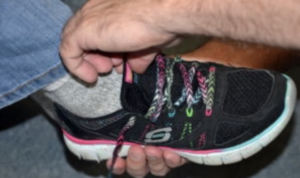 |
| Communicate with your clients. | Let clients know when you will be back, and how you will help them ambulate. |
| Keep bed in the lowest position for sedated, unconscious, or compromised clients. | This step prevents injury to clients should they attempt to get out of bed. |
| Avoid using side rails when a client is confused. | Side rails may create a barrier that can be easily climbed and create a fall risk situation for confused clients. |
| Keep assistive devices and other commonly used items close by. | Allow clients to access assistive devices quickly and safely. Items such as the call bell, water, and Kleenex should be kept close by, to avoid any excessive reaching. |
Lowering a Client to the Floor
A client may fall while ambulating or being transferred from one surface to another. If a client begins to fall from a standing position, do not attempt to stop the fall or catch the client. Instead, control the fall by lowering the client to the floor. Checklist 34 lists the steps to assisting a client to the floor to minimize injury to client and health care provider (PHSA, 2010).
Checklist 8.10.1 Lowering a Client to the Floor
Disclaimer: Always review and follow your agency policy regarding this specific skill.
Safety considerations:
- There is always a potential fall risk during transfers and ambulation. Prevention is key.
- If a client begins to feel dizzy, have them sit on a chair or the floor to avoid a fall.
- The head is the most important part of the body; always protect it as much as possible.
- In the event of a fall, stay with the client until help arrives.
- After a fall, always observe and evaluate a client for injuries prior to moving them. If the client remains weak or dizzy, do not attempt to ambulate them. Seek help.
- Document according to agency policy including the PSLS (client safety learning system).
| STEP | ACTION | ADDITIONAL INFORMATION |
|---|---|---|
| 1. | If a client starts to fall and you are close by, move behind the client and take one step back. | Look and be attentive to cues if a client is feeling dizzy or weak.
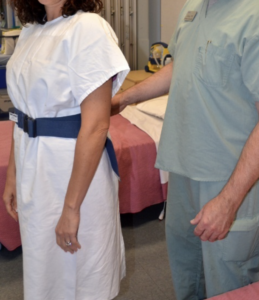 |
| 2. | Support the client around the waist or hip area or grab the gait belt. Bend your leg and place it in between the client’s legs. | Hand placement allows for a solid grip on the client to guide the fall.
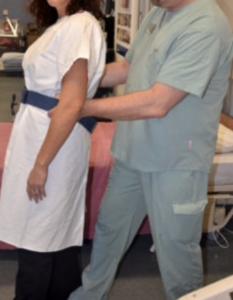 |
| 3. | Slowly slide the client down your leg, lowering yourself at the same time. First, always protect the head. | Lowering yourself with the client prevents back injury and allows you to protect the client’s head from hitting the floor or hard objects.
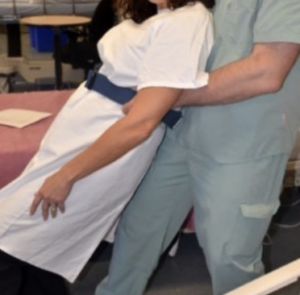 |
| 4. | Once the client is on the floor, observe and evaluate the client for injuries prior to moving. | Determines the client’s ability to get off the floor or if additional help is needed.
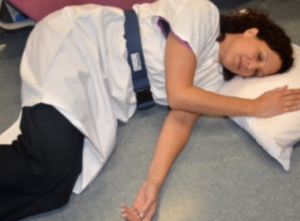 |
| 5. | Provide reassurance and seek assistance if required. | If required, stay with the client and call out for help. |
| 6. | If client is unable to get up off the floor, use a mechanical lift. | If client still feels dizzy or weak, using a mechanical lift will prevent injury. |
| 7. | Complete an incident report according to agency policy. | An incident report helps identify and manage risks related to client falls. |
Special considerations:
- Use a falls risk assessment tool for all clients according to agency policy.
- Younger clients may not be aware of the effects of medication and treatments leading to dizziness and orthostatic hypotension.
- Inform clients and family members about the potential risks for falls in the hospital. If informed, people are more likely to call for assistance.
- Always ensure call bell is in place. Many falls occur due to incontinence issues. The call bell allows client and family to obtain assistance quickly.
- If appropriate, educate client about home maintenance and safety to prevent falls when returning home.
- Fall prevention is interdisciplinary. Proper communication by the care team is required to prevent falls.
Watch the video Assisted Fall (2018) by Kim Morris of Thompson Rivers University School of Nursing.
LearningHub is a province-wide course registry and learning management system for the health authorities in British Columbia. Sign up to learn more about safely lowering a client to the floor.
Critical Thinking Exercises
- Name four fall prevention strategies that will help keep a client safe when ambulating in the hospital.
- A client is ambulating for the first time after surgery. Is it safe to encourage the client to ambulate independently?
- Many physiological risk factors can be identified from a routine point-of-care risk assessment to suggest risk for falls. Name three risk factors and three prevention strategies to manage these risks. For example, if a client has frequent toileting needs, a preventive action is to offer assistance to the toilet every hour, and to ensure the call bell is within reach at all times.
Summary
The determination of when to use a mechanical lift in the home setting is complex. It requires a careful assessment of the client’s motor, communication, and cognitive abilities; physical characteristics; and the physical environment of the home.
Mechanical lifts and transfer can efficiently help move clients from one place to another, whether it is from a bed to a bath or from a wheelchair to a toilet They are designed to aid health care staff, particularly HCAs when working with clients who have mobility challenges. Knowing how to properly lift or transfer clients can minimize the amount of manual effort required to do so and reduces exposure to the known injury risk factors of excessive force and awkward posture, contributing musculoskeletal injuries. And, when used properly, they present an effective and efficient solution for moving clients.
To use the principles of body mechanics effectively and safely, health care providers must have the required training to perform a point-of-care risk assessment, knowledge about transfer assistive devices, and an understanding of the procedures for safe client handling. In addition, knowing risk factors for positioning, transferring, and ambulation, along with understanding falls prevention, will help prevent injuries to staff and clients. The goal of this chapter has been to help reduce the incidence and severity of injuries related to client-handling procedures.
- What is the most common injury to health care workers, and how do these injuries occur?
- Lower back injury caused by a fall.
- Lower back injury while repositioning a client in bed.
- Shoulder injury due to repositioning clients.
- Neck injury when transferring a client. Wrist and hand injuries due to over- use while providing care.
- What is the preferred method for repositioning a dependent client in bed?
- Ceiling lift with the two persons assisting.
- Use the sliding sheet with two persons to assist.
- Manually lifting the client Both the first and third answers are correct.
- Use the bed pad with two persons to assist.
- One should not….
- Pull on the hemiplegic arm
- Use a ceiling lift with only one person.
- All the above are correct.
- Ignore the mobility status sheet.
- Work overbed rails.
- What is the Transfer Status Assessment used for?
- Used to lift a client.
- Assesses the ability to ambulate.
- Is to be used only by PT and OT.
- Used only once per admission.
- Assist in problem solving about what type of transfer is safe for a given level of client functioning.
- An injury to a team member…
- Adversely affects every member to the team.
- Can be prevented.
- Causes everyone on the team to work harder.
- Can reduce the quality of client care.
- All of the above are true.
- A mechanical lift is used when:
- You are new to the unit
- The client is minimal assist of one
- The client is unable to follow commands
- The client does not want to get out of bed
- You are alone
- Weight bearing as tolerated (WBAT) refers to a:
- Client can weight bear through the affected leg as they feel comfortable
- Weight bearing status
- Client being able to walk to the washroom independently
- The first two options are correct
- None of the above are correct
- Good caregiver body mechanics include working as close to the client as possible to reduce the “lever arm effect”
- False
- True
- The emotional status of the client can affect the transfer status of the client
- True
- False
Suggested Online Resources
- Agency for Health Care Research and Quality: Which Fall Prevention Practices Do You Want to Use? (2013). These universal fall risk precautions review physiological, anticipated, unanticipated, and environmental hazards with a focus on identifying risk factors and prevention strategies.
- BC Interior Health: Safe Client Handling (n.d.). This website lists excellent resources, including brochures and videos, about topics related to body mechanics, transfers, positions, and performing point-of-care risk assessments.
- BC Client Safety & Quality Council: Hospital Care for Seniors: 48/6 Approach (2012). This resource offers a model of care for hospitalized seniors (aged 70 and older) in British Columbia. It is an integrated care initiative that addresses six care areas of functioning through client screening and assessment (assessments are completed only where screening shows areas of concern) within the first 48 hours of hospital admission.
- Canadian Fall Prevention Education Collaborative: Canadian Fall Prevention Curriculum (2017). This website provides information and tool kits for preventing falls in the community and acute care settings.
- Centers for Disease Control and Prevention: Safe Client Handling Training for Schools of Nursing (2009). This resource was developed by the World Health Organization to create global awareness. It provides up-to-date algorithms for client transfers.
- Provincial Health Services Authority: Safe Client Handling (2010). These instructional video courses cover numerous topics including mechanical (ceiling) lifts, additional re-positioning techniques, transfers, and assisting a client off the floor.
Chapter 8 Attributions and References
Unit 8.3 Image Attributions
- Figure 8.3.7 Tripod position by Renée Anderson is licensed under a CC BY 4.0 International licence.
Unit 8.8 Image Attributions
- Figure 8.8.17 Standing with support of a walker by Renée Anderson is licensed under a CC BY 4.0 International licence.
- Figure 8.8.18 Assessment and instructions prior to ambulation by Renée Anderson is licensed under a CC BY 4.0 International licence.
- Figure 8.8.19 Preparing to move from chair to walker by Renée Anderson is licensed under a CC BY 4.0 International licence.
- Figure 8.8.20 Teenage boy on crutches with walking boot by Pagemaker787 is used under a Creative Commons Attribution-Share Alike 4.0 International license
- Figure 8.8.21 An illustration depicting walking on crutches by BruceBlaus is used under a Creative Commons Attribution-Share Alike 4.0 International license.
- Figure 8.8.23 An illustration depicting different cane types by BruceBlaus is used under a Creative Commons Attribution-Share Alike 4.0 International license.
Unit 8.9 Image Attributions
- Figure 8.9.1 (Source: Kiwipoint FDA, n.d.) With permission to use from Kiwipoint FDA
- Figure 8.9.2 (Source: Kiwipoint FDA, n.d.) With permission to use from Kiwipoint FDA
- Figure 8.9.3 (Source: Kiwipoint FDA, n.d.) With permission to use from Kiwipoint FDA
References
Anderson, R. Doyle, G. R. & McCutcheon, J. A. (2018). 3.3: Risk Assessment for Safer Patient Handling. In Clinical procedures for safer patient care. British Columbia Institute of Technology/BCcampus. https://pressbooks.bccampus.ca/clinicalproceduresforsaferpatientcaretrubscn/chapter/3-3-risk-assessment-for-safer-patient-handling/
Berman, A., & Snyder, S. J. (2016). Skills in clinical nursing (8th ed.). Hoboken, NJ: Pearson.
British Columbia Client Safety Learning System (BCPSLS) Central. (2015). BC PSLS blog. http://bcpslscentral.ca/.
Canadian Client Safety Institute. (2015). Reducing falls and injury from falls: Getting started kit. Retrieved from http://www.clientsafetyinstitute.ca/en/toolsResources/Documents/Interventions/Reducing%20Falls%20and%20Injury%20from%20Falls/Falls%20Getting%20Started%20Kit.pdf.
Canadian Patient Safety Institute. (2014) Resource Guide on Falls Prevention – For Home Care Service Providers. https://www.patientsafetyinstitute.ca/en/toolsResources/HomeCareSafety/Documents/Resources%20for%20home%20care%20providers%20-%20Resource%20guide%20on%20falls%20prevention.pdf
Cleveland Clinic. (2018a). Walkers. https://my.clevelandclinic.org/health/articles/15542-walkers.
Cleveland Clinic. (2018b). Crutches. https://my.clevelandclinic.org/health/articles/15543-crutches.
Cleveland Cinic. (2018c). Canes. https://my.clevelandclinic.org/health/articles/15541-canes.
Graf, C. (2006). Functional decline in hospitalized older adults. It’s often a consequence of hospitalization, but it doesn’t have to be. American Journal of Nursing, 101(1), 58-67. http://www.researchgate.net/publication/232182376_Functional_Decline_in_Hospitalized_Older_Adults_Its_often_a_consequence_of_hospitalization_but_it_doesnt_have_to_be.
Handicare. (2018). How to choose the proper sling. https://www.handicare.ca/blog/2018/08/24/how-to-choose-the-proper-sling/
Hook, M. L., & Winchel, S. (2006). Fall related injuries in acute care: Reducing the risk of harm. Clinical Practice, 15(6), 370-377.
HoverTech International. (2016). HoverMatt air transfer system. http://www.hovermatt.com/hovermatt.html.
Interior Health. (2012). Point-of-care risk assessment. https://www.interiorhealth.ca/sites/Partners/WHSresources/Documents/Point%20of%20Care%20Risk%20Assessment%20Tool.pdf
Interior Health. (2013). Manual transfer: One person assist with help. https://www.interiorhealth.ca/sites/Partners/WHSresources/Documents/Manual%20Transfers%20-%20One%20Person%20Assist%20with%20Help%20SWP.pdf.
Kalisch, B. J., Lee, S., & Dabney, B. W. (2013). Outcomes of inclient mobilization: A literature review. Journal of Clinical Nursing, 23(11-12), 1486-501. https://doi.org/10.1111/jocn.12315
National Institute for Occupational Safety and Health (NIOSH). (2010). Safe client handling training for schools of nursing. Retrieved from http://www.cdc.gov/niosh/docs/2009-127/pdfs/2009-127.pdf.
Peninsula Health. (1999). Falls risk assessment tool (FRAT). https://www2.health.vic.gov.au/about/publications/policiesandguidelines/falls-risk-assessment-tool.
Perry, A. G., Potter, P. A., & Ostendorf, W. R. (2018). Clinical nursing skills and techniques (9th ed.). St. Louis, MO: Elsevier-Mosby.
Potter, P. A., Perry, A. G., Stockert, P., Hall, A., Astle, B., & Duggleby, W. (2017). Canadian fundamentals of nursing (6th ed.). Milton, ON: Mosby.
Potter, P. A., Perry, A. G., Stockert, P. A., & Hall, A. (2011). Basic nursing (7th ed.). St. Louis, MO: Elsevier-Mosby.
Provincial Health Services Authority (PHSA). (2010). Workplace health – Safe client handling [Online courses]. http://learn.phsa.ca/phsa/clienthandling/.
Registered Nursing. (n.d.). Ergonomic principles: NCLEX-RN. https://www.registerednursing.org/nclex/ergonomic-principles/.
Sanguineti, V. A., Wild, J. R., & Fain, M. J. (2014). Management of postoperative complications: A general approach. Clinics in Geriatric Medicine, 30(2), 261-270. https://doi.org/10.1016/j.cger.2014.01.005.
South Island Alliance. (n.d.). Level of assistance definitions. https://www.sialliance.health.nz/UserFiles/SouthIslandAlliance/File/LEVEL%20OF%20ASSISTANCE%20DEFINITIONS%202016.pdf.
Stewart, D. (2018). Ceiling lift sling information. https://mobilitybasics.ca/ceiling-lifts/slings.
Titler, M. G., Shever, L. L., Kanak, M. F., Picone, D. M., & Qin, R. (2011). Factors associated with falls during hospitalization in an older adult population. Research and Theory for Nursing Practice: An International Journal, 25(2), 127-152. https://doi.org/10.1891/1541-6577.25.2.127.
Winnipeg Regional Health Authority (WRHA). (2015). Safe client handling assessment form. http://www.wrha.mb.ca/professionals/safety/files/SafeClientHandling/SafeClientHandlingAssessmentForm.pdf.
Winnipeg Regional Health Authority (WRHA). (2008). Client assessment procedures and screening tool. http://www.wrha.mb.ca/professionals/safety/files/SafeClientHandling/ClientAssessmentProcedure.pdf.
WorkSafeBC. (2006). Handle with care: Client handling and the application of ergonomics (MSI) requirements. https://www.worksafebc.com/en/resources/health-safety/books-guides/handle-with-care-client-handling-application-ergonomics-musculoskeletal-msi-requirements?lang=en&origin=s&returnurl=https%3A%2F%2Fwww.worksafebc.com%2Fen%2Fsearch%23q%3Dtransfer%2520assist%2520devices%2520for%2520safer%26sort%3Drelevancy%26f%3Alanguage-facet%3D%5BEnglish%5D.
WorkSafeBC. (2008). Understanding the risks of musculoskeletal injury (MSI): An educational guide for workers on sprains, strains, and other MSIs. http://www.worksafebc.com/publications/Health_and_Safety/by_topic/assets/pdf/msi_workers.pdf.
WorkSafeBC. (2010). Client handling. https://www.worksafebc.com/en/health-safety/industries/health-care-social-services/topics/client-handling.
WorkSafeBC. (2013). Preventing musculoskeletal injury (MSI). http://www.worksafebc.com/publications/health_and_safety/by_topic/assets/pdf/msi_employers.pdf.
World Health Organization. (2018). Assistive devices and technology. https://www.who.int/disabilities/technology/en/.

